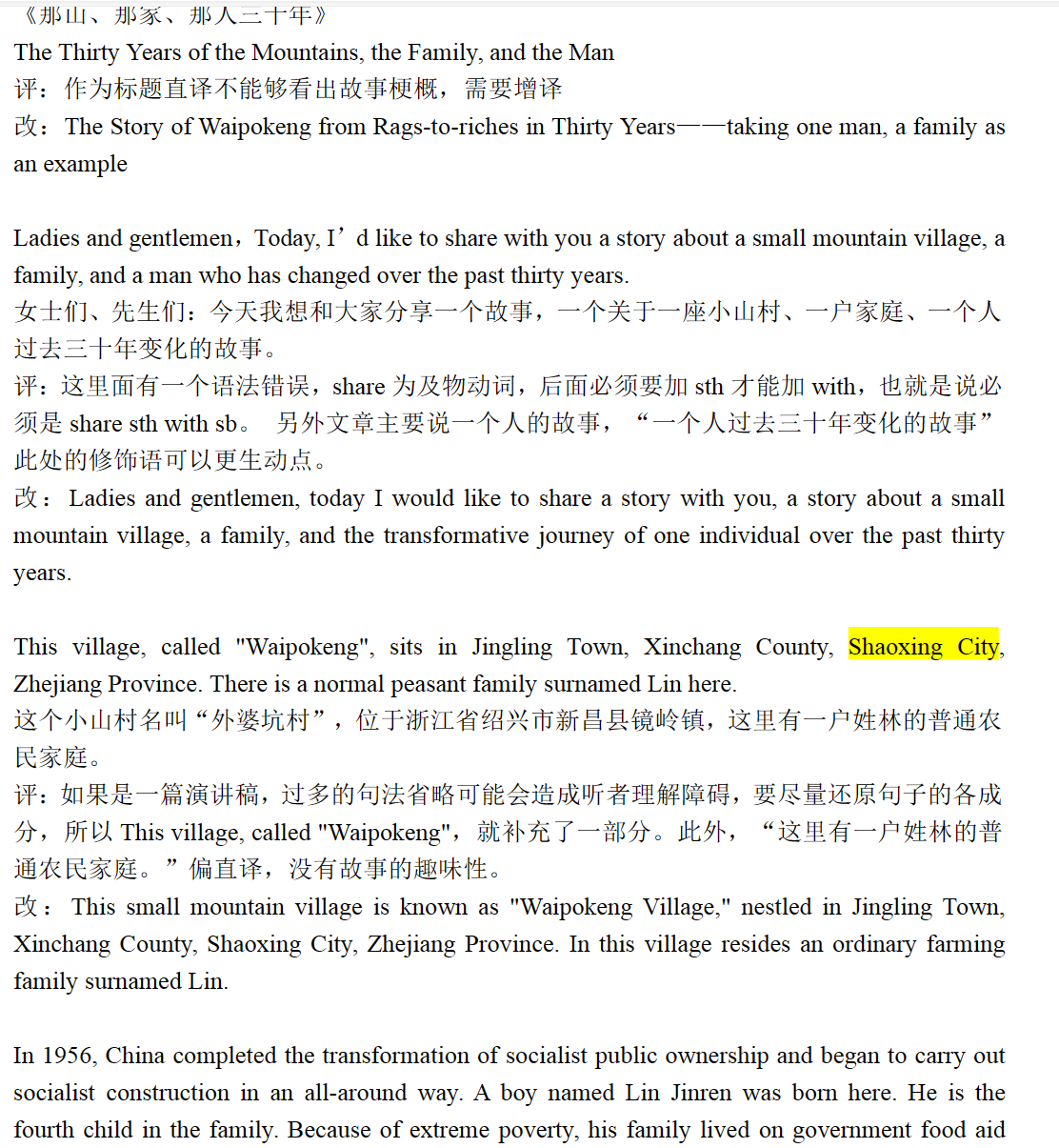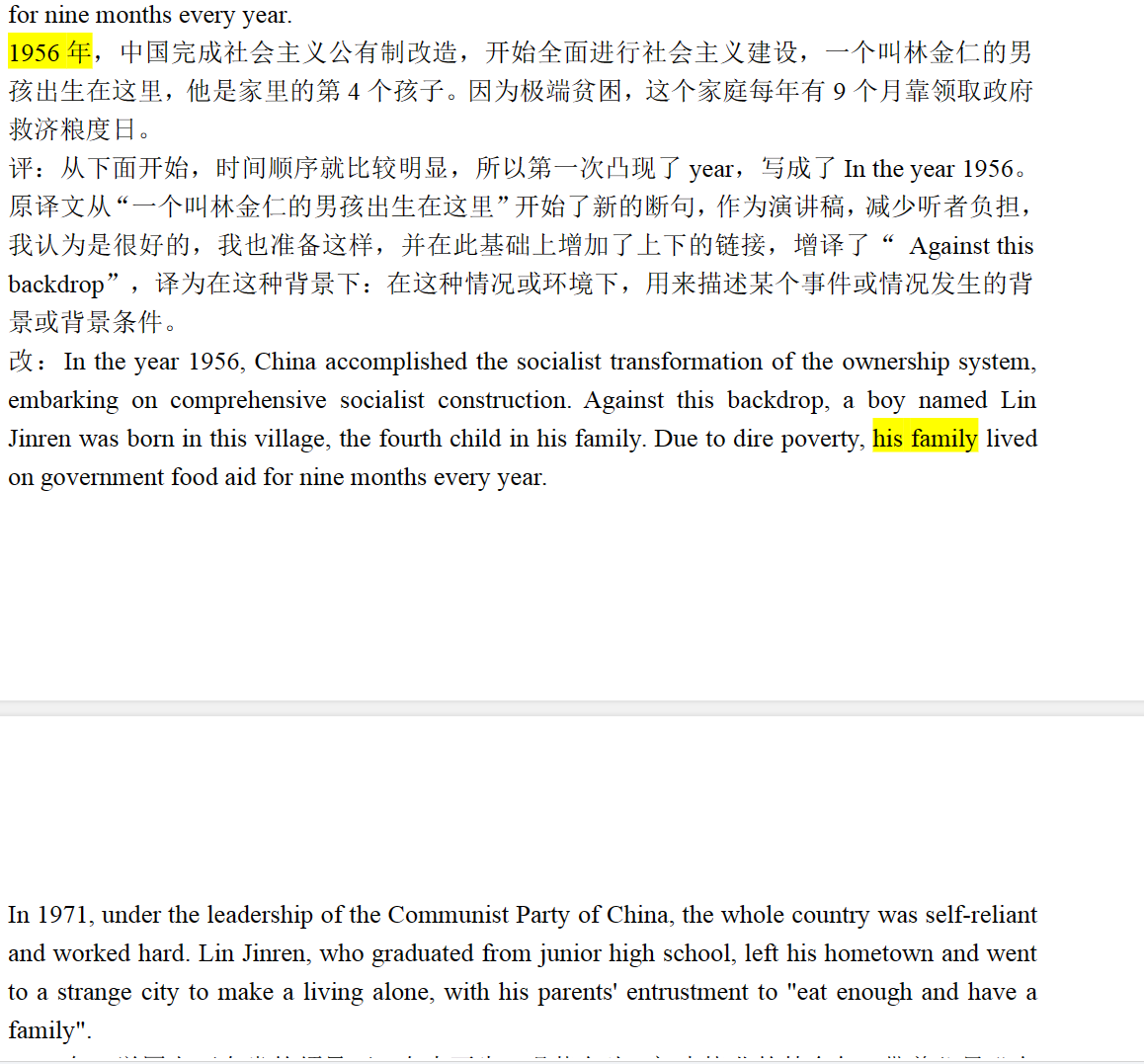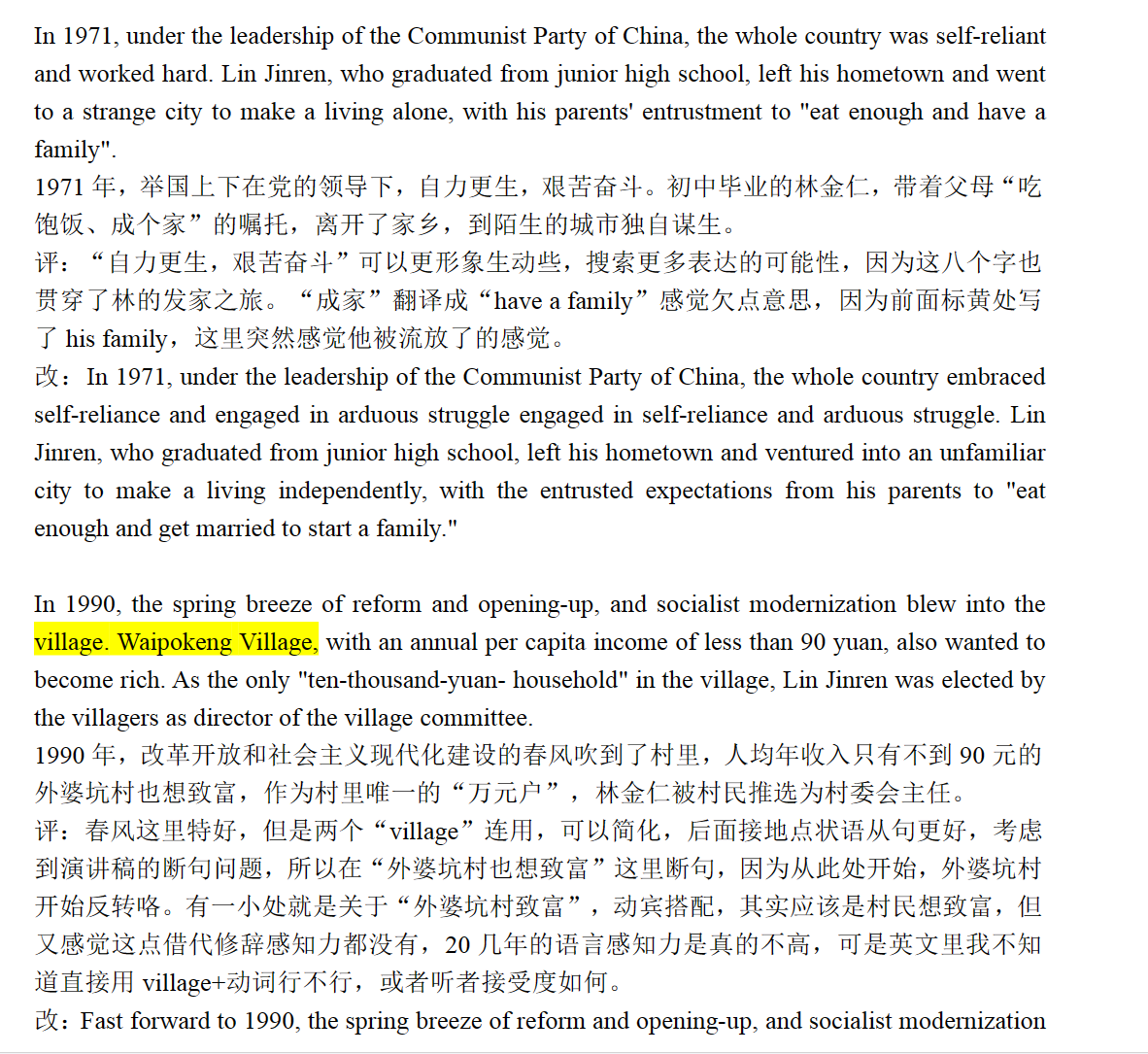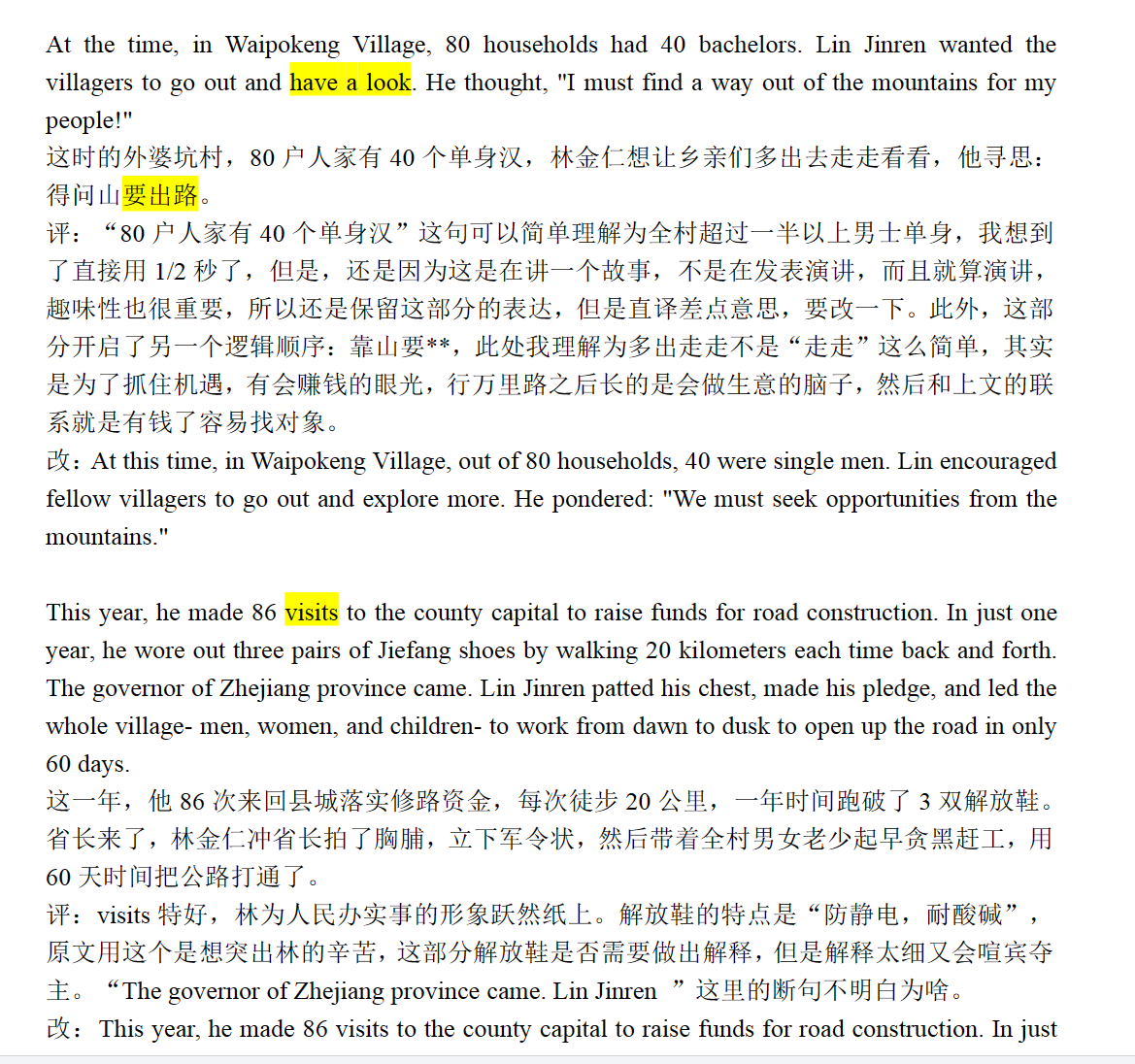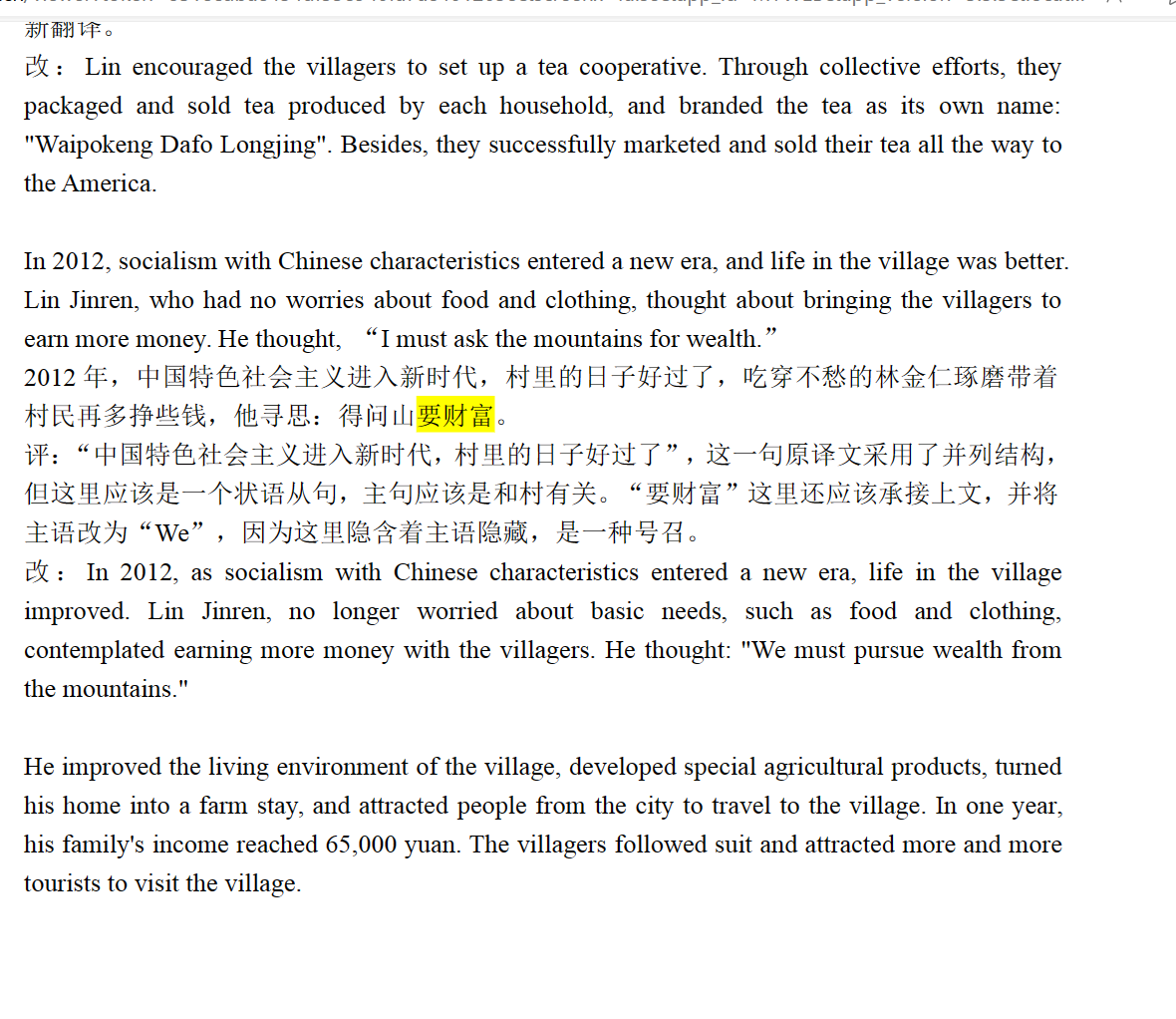第一次作业:绍兴古桥文化
要求:Translation appreciation:
译文赏析:阅读如下原文和译文,请对此翻译进行评价,分析其可圈可点或者不尽人意之处。感兴趣的同学可以提出你自己的版本!
绍兴古桥:璀璨的大越文化
在水乡绍兴,至今仍完好保存着唐宋元明清以及民国时期的古桥700余座,最古老的可以追溯到唐朝,最新的建于民国时期。绍兴古桥类型众多,布局灵活,功能齐全,其高超的建桥技术和深邃的表现艺术,展示了优秀璀璨的大越文化。在中国桥梁史上有重要地位、现存最古老的城市桥梁为绍兴城内宋代的八字桥,其状如八字,故得名。住在这一带的人们,每一天都要经过这座古桥,每个人都因桥的存在而感到幸福和骄傲。这里的游客也很多,他们来自五湖四海,有的一边欣赏景观,一边赞叹古桥雄伟的风貌。绍兴有许多桥梁名字很吉祥。过桥的各种习俗也由来已久,例如,结婚、孩子满月等。
Time-honored Shaoxing Bridges:a Showcase of Splendid Yue Culture
Shaoxing, which is crisscrossed by numerous rivers and lakes, is home to a large number of ancient bridges, among which more than 700 ones have been well preserved, with the oldest dated back to the Tang dynasty(618-907) and the youngest to the early decades of the Republic of China (1911-1949).
These bridges are in a variety of kinds, shapes and functions, whose advanced technology and profound art form showcase how splendid the Yue culture was. And Bazi Bridge in Shaoxing is the oldest urban bridge of China, taking its name from its shape, like the Chinese character “八”. It was built during the Song dynasty, which plays an important role in China’ bridge history. Now it brings a sense of happiness and pride to the local residents in the neighborhood. It also hosts a lot of tourists each day, from home and abroad, who enjoy the its unique scenery and marvel at its history and beauty. Some of the bridge names suggest auspiciousness and happiness. Therefore on some special occasions, such as wedding day, baby’s one-month celebration, etc., local people would cross those bridges, hoping this will bring them good luck.
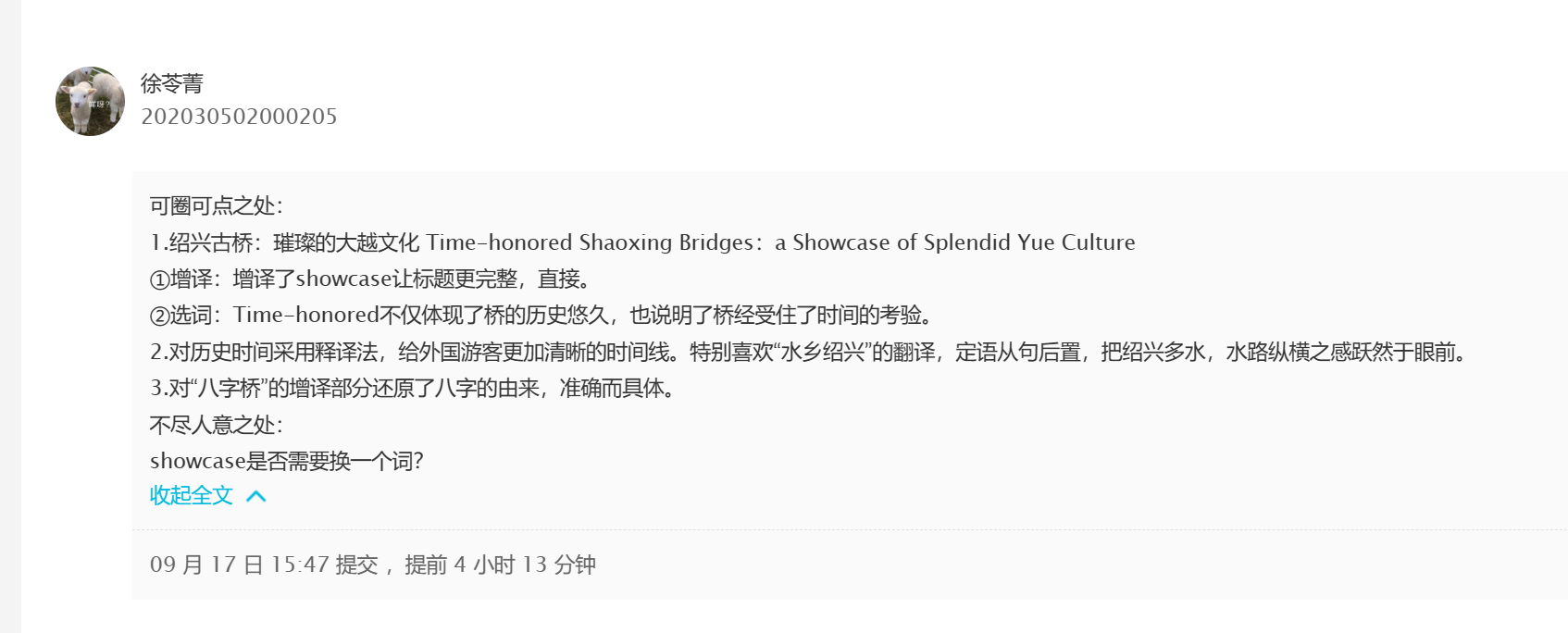

第二次作业 探访大禹陵case study
任务详情
地方文化外译第二次作业:探禹穴Case study of the translation at Dayu Mausoleum
史学家司马迁南游访古,曾“上会稽,探禹穴”。大家利用国庆假期探索绍兴地方文化。同时点评其中英文标识,例如门口的一个标识牌为必做题,首先,对原文和原译文进行赏析和评价,指出优缺点;然后给出你的原创版本,一定是你的版本哦!老师也会做滴,我们一起交流。本次作业100分。
学有余力的同学还可以分享景点中其他的翻译。附加分8分
徐苓菁
202030502000205
第一句:全域旅游景点介绍 10分
Introduction to all-for-one Tourism Scenic Spots
评价赏析:从目的论角度看,游客不太可能一下子理解all-for-one的意思;此处全域旅游经查询是指全景化的旅游系统,是一种旅游理念,此处一种方法是将全域旅游作为背景放后面,一种是省略。
我的译文:1. Introduction to Scenic Spots 2. Introduction to Scenic Spots under All-for-one Tourism Plan
第二句:赏稽山鉴水,游千年古城 10分
Enjoy Kuaiji Mountain and Jianhu Lake Visit the Thousand-year-old Acient Town
评价赏析:英文翻译对仗工整,但英文中动词较少,可省略动作,强调实物——美景即可;可将两句结合,用介词in+city,串联前后的关系;前面禹穴是音译,而禹池确实音译+意译,不太妥,应该两者统一一下。
我的译文:Wonderful Landscape of Kuaiji Mountain and Jianhu Lake in Time-honored city— Shaoxing
第三段:大禹陵景区 Daya Mausoleum Scenic Area 40分
大禹陵,古称禹穴,是大禹的葬地。它背靠会稽山,前临禹池,位于绍兴市越城区东南稽山门外会稽山麓,距市中心六公里,1996年被国务院命名为全国重点文物保护单位。大禹是上古时代一位治水英雄,中国第一个王朝夏朝的开国之君,被后人尊为“立国之祖”。会稽山为古代名山,《调礼•夏官•职方氏》. 曾将会稽山列为九大名山之首。
Dayu Mausolem (Called Yuxue in the ancient times) in the burial ground of Dayu. It is backed against Kuaiji Mountain, close to Yu Pool in the front, located at the foot of Kuaiji mountain outside Jishan Gate in the southeast of Yuecheng District, Shaoxing, 6 km from the urban center , regarded as the national key cultural protection unit by the State Council in 1996. Dayu is a water-governance hero of the remote ages, and a monarch that founded the Xia Dynasty as the first dynasty of China, reputed as the "Ancestor founding the State by descendants. Kuaiji Mountain was the famous mountain in ancient times. Zhouli Xiaguan Zhifangshi once listed Kuaiji Mountain as No1 Mountain among nine famous mountains.
评价赏析:标题中scenic多余。有些地方如Mausolem和burial ground重复,有些地方如《调礼•夏官•职方氏》这本书多余,因为对介绍会稽山的帮助不大。可以直接地点,且英文中小地点在前。对夏朝可进行增译,因为外国游客也会对突然出现的朝代没有直接的时间概念。
我的译文:Daya Mausoleum
Dayu Mausolem (called Yuxue Cave in the ancient times) is backed against Kuaiji Mountain and front facing Yuchi Pool, located at the foot of Kuaiji mountain outside Jishan Gate in the southeast of Yuecheng District, Shaoxing, 6 km from the urban center, regarded as the national key cultural protection unit by the State Council in 1996. Dayu is a water-governance hero of the remote ages, and a monarch that founded the Xia Dynasty, which is the first dynasty of China, reputed as the "Ancestor founding the State" by descendants. Kuaiji Mountain was the famous mountain in ancient times, which was once listed as the top of the nine famous mountains.
第四段:东湖景区 East Lake Scenic Area 40 分
东湖在绍兴城东约五公里处,以山明、水秀、岩奇、洞幽而闻名。以崖壁、岩洞、石桥、湖面巧妙结合,成为著名园林,是浙江省的三大名湖之一。昔日秦始皇东巡至会稽,于此供刍草而得名东湖。东湖虽小,但因它的奇石、奇洞所构成的奇景使东湖成为旅游业界人士公认的罕见的“湖中之奇”。
East Lake is 5 km from the east of Shaoxing, famous for beautiful mountains, charming water, strange rocks and serene caves. Due to the exquisite combination of cliffs, caves, stone bridges and lake surfaces, it has become a famous garden, regarded as one of three famous lakes in Zhejiang. In the past, the first emperor of the Qin Dynasty visited Kuaiji Mountain in the east, and the forage was provided here, hence the name “East Lake”. Although East Lake is samll, it has become the rare wonder among lakes recognized by the personnel from the toursim industry, due to the wonderful landscape composed of strange stones ans surprising caves.
评价赏析:标题中scenic多余。将重点信息浙江省的三大名湖提前。其中小的、琐碎的信息较多,需要对其进行合译。在全域旅游的背景下,可将三大名湖的另外两处补充出来。将信息分层后,后面的奇石等内容可以和前面的东湖概貌一起说,因为还是在介绍景点,而东湖得名由来则提到地点之后,让外国游客一开始就知其所以然。
我的译文:East Lake Area
The East Lake, five kilometers east of Shaoxing, is one of the three most famous lakes in Zhejiang Province, together with the West Lake of Hangzhou and the South Lake of Jiaxing. The first emperor of Qin Dynasty paid a visit to Kuaiji Mountain on his eastern tour, where the forage was provided, hence the name "the East Lake". It is featured with picturesque mountains, gorgeous waters, unique rocks, and serene caves. Small as it is it is recognized as rare wonder among lakes due to its unique rocks, and serene caves.
补充译文:为了交作业已来不及重游大禹陵,网上找到大禹陵的一个介绍图片。
此处我认为景区全景应该用:Full View of Scenic Area
因为下面的全景只是地点位置手绘,不是真正意义上的picture,view更加贴近概貌的理念。
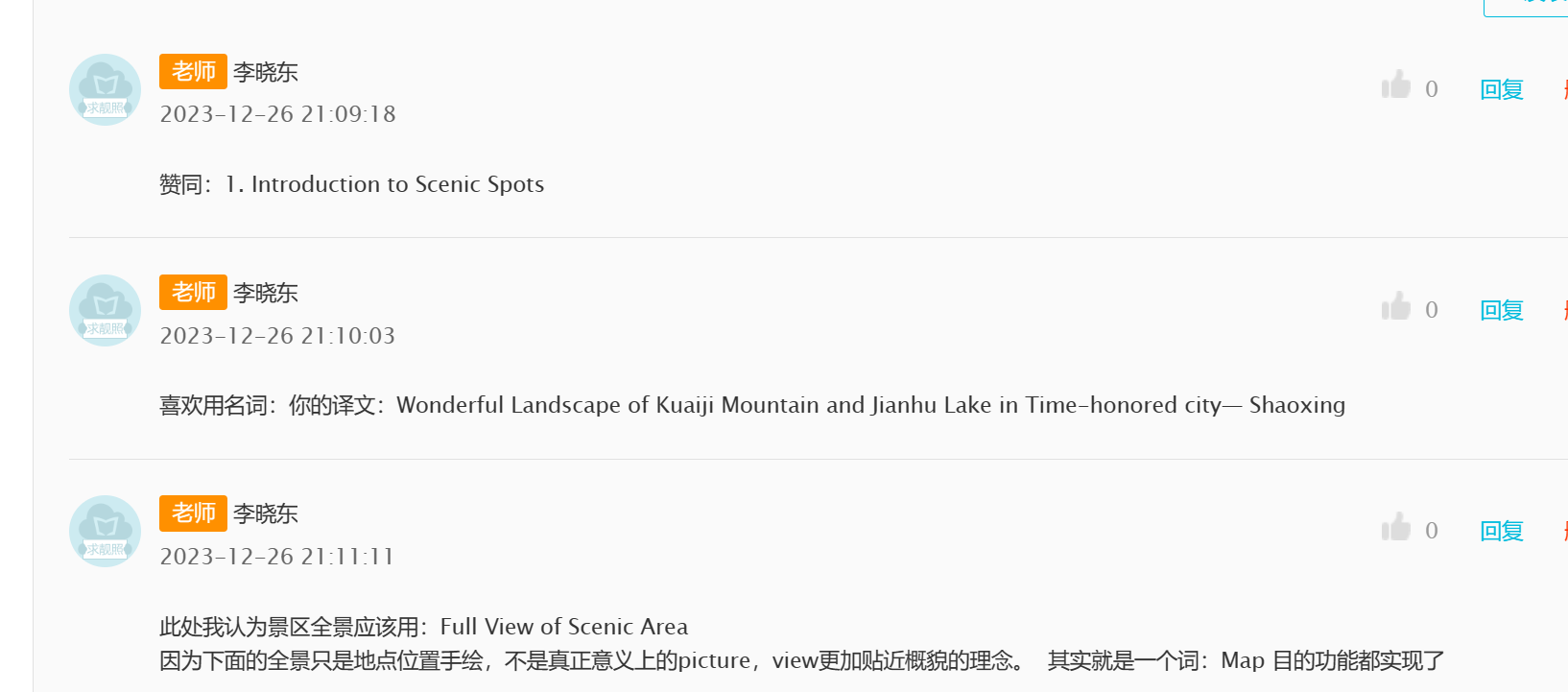
第三次作业:地理
要求:借鉴如下英文译文,翻译自己的版本,体会汉译英时候中英思维方式的不同,恰当地使用合译、省译和语序调整等,提高译文的质量。
原文:中国地处亚洲东部,是世界上人口最多的国家。它地域辽阔,960万平方公里的土地上高山耸峙,大河奔流,湖泊如境,丘陵起伏,平原无垠,盆地肥沃。中华民族是勤劳智慧的民族,历来依靠自己的力量办自己的事情。作为世界四大文明古国之一,中国有着悠久的历史和灿烂的文明。历史为今人留下了令人惊叹不已的文化遗产,其中珍贵文物、名胜古迹、雄伟建筑等不胜校举。无论是从文学思想还是到科学、技术、政治和军事方面,各个历史时期都见证了其伟大成就对世界的贡献。中国文明的历史本身就是奇迹的历史。
原译文:China lies in the east of Asia and it has the largest population in the world. China has animmense land territory totaling 9.6 million square kilometersr. On this vast area of land, there are towering mountains, rushing rivers, calm lakes undulating hills, boundless plains and fertile basins. The Chinese nation is an industrious and ingenious nation, always relying on its own efforts to handle its own affairs. As one of the world's four countries of great ancient civilization, China is a large country with a long history of civilization. China today is left with innumerable cultural heritages from the long past, including priceless relics, historicsites, scenic spots, and edifices of architectural richness, too numerous to mention one by one. Various historical periods have witnessed the significant contribution of its great achievements to the world ranging from literary and ideological to scientific, technological, political and military aspects. China's history of civilization is a history of wonder in itself.
你的译文:提示注意文化外译中的Acceptance, 目的语读者的接受度哦。

第四次作业: 绍兴打造“文学之城”
翻译如下文章: 并总结其中的难点和你的解决方法
绍兴打造“文学之城”
今年是唐代诗人贺知章逝世1270周年。19日上午,由市文联、市文艺评论家协会主办的“乡情诗风”——纪念贺知章逝世1270周年暨绍兴诗歌创作与发展研讨会在绍兴举行。研讨会上,省、市诗歌研究专家、诗人等共同为绍兴诗歌的创作与发展把脉。
贺知章早年迁居山阴(今绍兴市),少时即以诗文知名,更是浙江历史上第一位有资料记载的状元,其中,《咏柳》《回乡偶书》两首诗歌脍炙人口、千古传诵。与会专家表示,我们要进一步挖掘先贤贺知章身上的文化内涵,进一步做好传承与发展的文章,共同推进绍兴诗歌的繁荣和发展,进而打造“文学之城”。
记者从研讨会中了解到,绍兴将引进、培养专业的“文学人才”,为人才创造良好的创作条件。“绍兴是文学家鲁迅的故乡,每年都有百万余人来绍兴‘朝圣’,因此绍兴本身就具有文学的底蕴,具备‘文学之城’的基础条件。”与会专家表示。
译文:
Shaoxing: A City Bursting with Literature
This year marks the 1270th anniversary of the passing of the Tang Dynasty poet He Zhizhang. To commemorate He Zhizhang while focusing on the creation and development of poetry in Shaoxing, the "Rural Sentiment Poetry Symposium" is jointly organized by the Shaoxing Municipal Literary Federation and the Municipal Literary Critics Association on the morning of the 19th. At the symposium, poets and experts in poetry research from the province and the city jointly discussed the creation and development of poetry in Shaoxing.
He Zhizhang moved to Shanyin (now Shaoxing) in his early years and gained fame as a poet and writer from a young age. He is also the first recorded Zhuangyuan (top scholar/ champion in test) in the history of Zhejiang. His poems, especially The Willow and Home-Coming are widely acclaimed and have been passed down through the ages. Experts at the symposium expressed the need to further explore the cultural connotations embodied in the literary legacy of He Zhizhang, and to make continuous efforts in inheritance and development to collectively promote the prosperity and development of poetry in Shaoxing, which aims to contribute Shaoxing to a city bursting with literature.
It was revealed during the symposium that Shaoxing will introduce and cultivate professional literary talents, creating favorable conditions for their creative work. One of the experts at the symposium stated, "Shaoxing is the hometown of the great Chinese writerLu Xun, and over a million people “pilgrimage” to Shaoxing every year. Therefore, Shaoxing inherently possesses a literary heritage and has the basic conditions to become a 'City Bursting with Literature.'"
难点:
①汉语抽象之处较多,如标题以及正文中的的“打造……之城”,第一段的“为……把脉”,第三段中的“朝圣”。
②文中的修饰语颇多,如:“由市文联、市文艺评论家协会主办的“乡情诗风”——纪念贺知章逝世1270周年暨绍兴诗歌创作与发展”这一长串都只是为了修饰研讨会。另外,研讨会,Conference、Proceedings、Meeting、Seminar、Symposium 等选择。
③时态的选择:文章报到时,是否只是准备打造,时态选择什么?贺早年的事迹和他是历史上第一个浙江状元这个事实的时态选择应该不一样。
解决方法:
①尝试减少抽象语,如“打造”直接省略,并转换中英文思维差异,将“为……把脉”就理解为“关心……发展”,第一段中绍兴出现很多,在绍兴举行就可以删除,放到“由市文联、市文艺评论家协会”中,变成“由绍兴市文联、市文艺评论家协会”简化表达。“朝圣”此处我也没有想到更好的表达,其实这里的理解应该是,很多人就如同是鲁迅文学的使徒,那这种使徒用“朝圣”一词似乎没关系,所以此处我也只是加了引号。
②“由市文联、市文艺评论家协会主办的“乡情诗风”——纪念贺知章逝世1270周年暨绍兴诗歌创作与发展”这一句和第一句是具有相关性的,所以相同的部分我选择了省译,并且将SL做了顺序调整。搜索资料,我最终选择了Symposium一词代表研讨会,因为symposium所指的研讨会是指某一特定领域,比较正式。

第五次作业理解当代中国用英文讲述如下外婆坑致富的故事,并评价原译文不妥的地方。
